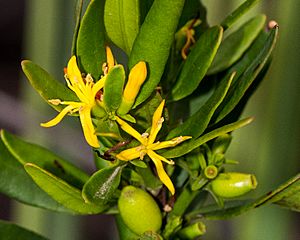Atkinsonia facts for kids
Quick facts for kids Atkinsonia |
|
|---|---|
 |
|
| A. ligustrina: fruit & flowers | |
| Scientific classification | |
| Genus: |
Atkinsonia
|
| Species: |
ligustrina
|
| Synonyms | |
|
|
Atkinsonia is a special type of plant called a hemi-parasitic shrub. This means it gets some of its food from other plants, but it can also make its own food using sunlight. It has leaves that grow opposite each other and flowers that are yellowish, later turning rusty-red.
You can find this plant in Eastern Australia. There is only one type of Atkinsonia plant, and its scientific name is A. ligustrina. It belongs to the mistletoe family, which is known for its showy flowers. People sometimes call it Louisa's mistletoe.
Contents
What it Looks Like
Atkinsonia ligustrina is a strong, upright evergreen shrub. It usually grows about 1 to 2 meters (3 to 6 feet) tall. It gets some nutrients by attaching to the roots of other woody plants. But it also makes its own food through photosynthesis, just like most plants. It has 24 chromosomes in its cells.
Roots
The main roots of Atkinsonia ligustrina live for a long time. They are thick and have many marks on them. If these roots get hurt, they turn blue. The smaller roots that attach to other plants (called haustoria or taproots) do not live as long. They also don't have tiny root hairs.
Stems and Branches
This plant has many reddish-brown branches. These branches split into smoother, smaller branchlets. These smaller parts can break off easily.
Leaves
The leaves grow in pairs, opposite each other along the branches. Sometimes they might look scattered if some have fallen off. They are a bit thick and spread out. When new, they are bright green, then become a duller green. Each leaf is about 2–5 cm (1–2 inches) long and ½–1 cm (0.2–0.4 inches) wide. The underside of the leaf feels soft. The edges are smooth and curve down to a short leaf stalk, about 2 mm long. The tip of the leaf is blunt.
Flowers
The flowers of Atkinsonia ligustrina smell sweet. They grow in groups of up to eight flowers. These groups appear where the leaves meet the stem, usually in November. Each flower has a short stalk. It also has small leaf-like parts called bracts near it.
Most flowers have six (sometimes up to eight) petals. These petals are narrow strips, about 7 mm long. They start yellow and later change to a rusty-red color. The parts that hold pollen (called anthers) are short and pale yellow. They are joined to the bottom of the petals.
Fruits
The fruit looks like a small, oval or egg-shaped berry, about 1½ cm (0.6 inches) long. When it's new, it's green. But when it's ripe, around March, it turns red. Inside, there's a thin, sticky layer around the seed. Animals eat these fruits, or they fall off before the next year's flowers start to grow.
How it Got its Name
A botanist named Allan Cunningham first found this plant in 1817. He called it Nuytsia ligustrina. Later, in 1861, Ferdinand von Mueller officially described the plant. When he saw the fruits, he decided it needed its own new group, or genus, called Atkinsonia. So, in 1865, he gave it the name Atkinsonia ligustrina.
Name Meaning
The genus name, Atkinsonia, was given to honor Louisa Atkinson. She was a plant collector who discovered many new plants in the Blue Mountains. She found the very plant that Cunningham used for his description. The second part of the name, ligustrina, means "resembling Ligustrum". Ligustrum is another type of plant, and "-ina" is a Latin ending that means "like" or "similar to".
Where it Lives
Louisa's mistletoe only grows in a small area of the Blue Mountains in Australia. This area is inland from Sydney. You can find it roughly between the towns of Linden, Mount Wilson, Mount Victoria, and around Marrangaroo.
Its Home
This plant likes to grow in open areas like woodlands and heathlands. It is often found on rocky ridges where it gets a lot of sun.
How it Interacts with Nature
One Atkinsonia ligustrina plant can attach to the roots of many different plants nearby at the same time. Its special roots (called taproots) have been found connected to the root systems of several other plants. These include:
- Acacia intertexta
- A type of Caustis plant
- Dillwynia ericifolia
- Eucalyptus piperita
- Leptospermum attenuatum
- Monotoca scoparia
- Platysace linearifolia
The small, open, and sweet-smelling flowers of A. ligustrina are pollinated by insects. The fruit has a sticky layer around the seed. Young Atkinsonia plants can grow quite a bit even before they connect to a host plant.
See also
 In Spanish: Atkinsonia para niños
In Spanish: Atkinsonia para niños

